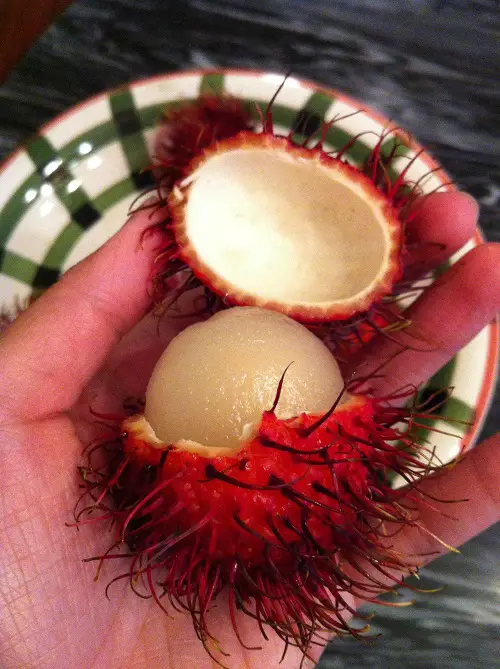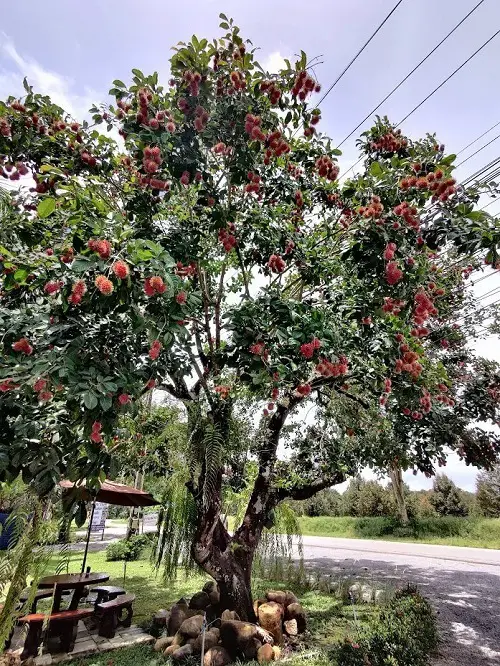Follow this ultimate guide and learn Everything About Growing Rambutan with expert care tips and relish them homegrown!

Learn Everything About Growing Rambutan with this detailed guide, and enjoy this nutritious fruit in smoothies and salads.
Find the Difference Between Rambutan and Lychee
What are Rambutans?
Rambutan (Nephelium lappaceum) is a fruit species that originates from Southeast Asia, specifically Thailand, Indonesia, and the Philippines. It belongs to the soapberry family (Sapindaceae).
It has a distinct appearance, with a red, hairy exterior resembling a sea creature; it grows in large clusters, measuring about 2-3 cm in diameter or roughly the size of a golf ball. A translucent, inedible layer with a hard seed at the center encloses the juicy white flesh. Rambutan is commonly consumed fresh but can also be found in canned, dried, or processed forms, such as juice or other sweet treats.
The fruit trees can be male, female, or hermaphrodite and are evergreens that can reach a height of up to 15-80 feet with 15-40 feet spread. Leaves are alternate, slightly leathery, and elliptic to oblong in shape with yellow or bluish-green veins underneath.
When the fruit falls from the tree, it can create a slippery mess in the garden. Therefore, it is recommended to plant trees far from sidewalks and other high-traffic areas to avoid accidents.
USDA Zones: 10 a and above
Note: An established rambutan can produce 3000-6000 fruits across a 4-6 week period.
Where Can You Grow Rambutans?
Rambutan trees can be grown in tropical or semi-tropical climates, requiring warm temperatures, as anything below 50F or 10C can be fatal for them. While they are most commonly grown in Florida and some parts of California, individuals can still attempt to grow them in a greenhouse.
Growing Rambutan from Seeds

You can grow a rambutan tree from both seeds or seedlings. Growing a rambutan from seed is an easy process, although the seedlings may take several years to bear fruit. You can purchase seeds online or take them from fruits.
- First, extract the pale brown, elongated seed from a ripe rambutan fruit and thoroughly wash it, as the fruit’s flesh and juices can hinder germination.
- Sow the seed by pressing into a soilless seed-starting mix consisting of 4 quarts shredded peat moss or coconut coir, 4 quarts vermiculite, one tablespoon superphosphate, and two tablespoons ground limestone in a small plastic nursery pot with drainage holes.
- Cover the seed lightly with the moistened growing mixture and keep the soil moist in a bright location. Rambutan seeds typically germinate within 9 to 25 days.
Note: In about two years, the tree can be transplanted outdoors.
Look at the Best Asian Fruits You Must Try
Growing Rambutan Indoors
Rambutan trees are sensitive to cold temperatures and can only thrive outdoors year-round in frost-free locations. However, they can be grown in large pots and brought indoors within USDA plant hardiness zones 4b to 11. During the summer months, potted rambutans should be placed outside and brought inside as soon as nighttime temperatures drop below 55 degrees F.
- To grow these trees in pots, smaller cultivars should be started in 12- to 14-inch diameter pots and be transferred to larger ones when necessary.
- Larger rambutan cultivars, on the other hand, should be started in 16- to 30-inch diameter pots with a 14-inch depth; use nutrient-rich potting soil for this purpose.
Best Rambutan Varieties
- Azimat
- Ayer Mas
- Chooi Ang
- Peng Thing Bee
- Atjeh Koonig
- Lebak Bulus
- Sinyonya
- Rapiah
- Binja
- Ya Tow
- Lebakbooloos
Requirements for Growing Rambutan

Location
Rambutan trees require full sun or partial shade for optimal growth. They should be planted in a location that receives at least 6-8 hours of direct sunlight daily.
It is important to avoid placing the tree in an area that receives too much direct afternoon sunlight, as this can result in sunburn and scorching of the leaves.
Soil
Rambutan trees prefer a rich, well-drained soil with a pH of 5.5-6.5. The soil should be high in organic matter and slightly acidic, with good drainage.
Sandy loam or clay loam soils are ideal for growing rambutans. If the soil is too sandy or too clayey, then it may need to be amended with compost or other organic matter to improve its structure and water-holding capacity.
Water
Rambutan trees need consistent watering throughout the year, although they can withstand short periods of drought. Water once a week with 1 inch of water when there is no rainfall.
If growing in pots, water the rambutan whenever the top layer of soil feels dry. Allow water to run through the drainage holes at the base of the pot. During cool weather or winter, reduce watering.
Temperature and Humidity
Rambutan trees prefer warm, humid environments. They thrive in temperatures between 70-90°F (21-32°C) and relative humidity of at least 70%.
They can tolerate temperatures as low as 50°F (10°C) but need protection from frost.
Check out Fruits that Don’t Grow on Trees
Rambutan Tree Care
Fertilizer
For newly planted rambutan trees, you should fertilize every three months with a balanced fertilizer such as 10-10-10. Apply 1 tablespoon of fertilizer per square foot of soil and mix it into the soil around the tree, avoiding contact with the trunk.
You should also fertilize your established rambutan tree every three months during the growing season with a balanced fertilizer such as 10-10-10. Apply 1/2 tablespoon of fertilizer per square foot of soil and mix it into the soil around the tree, avoiding contact with the trunk.
Pests and Diseases
Pests like Fruit borer and Acrosircops crammella can damage the stem; chemical procedures can treat these.
Powdery mildew can also attack your rambutan trees and harm the fruit, making them drop early. To control this, spray the affected area with sulfur, often in the early stage.
Harvesting Rambutans
Rambutans can be harvested using a pair of pruning shears or a sharp knife. The fruit should be cut off the tree without damaging the stem, as this will help to preserve the fruit’s quality and ensure that the tree will continue to produce.
It is best to harvest the fruit when it is ripe, typically in the late summer or early fall. When picking the fruit, it is important to be mindful of any thorns on the tree, as they can cause injury. After harvesting, the rambutans should be stored in a cool, dry place until they are ready to be eaten.





